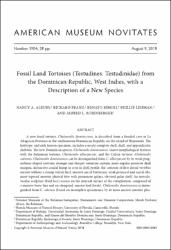| Author | Albury, Nancy A. | |
| Author | Franz, Richard | |
| Author | Rimoli, Renato | |
| Author | Lehman, Phillip | |
| Author | Rosenberger, Alfred L. | |
| Accessioned date | 2024-06-15T16:39:00Z | |
| Available date | 2024-06-15T16:39:00Z | |
| Year | 2018 | |
| Citation | Albury, N. A., Franz, R., Rimoli, R., Lehman, P., & Rosenberger, A. L. (2018). Fossil land tortoises (Testudines: Testudinidae) from the Dominican Republic, West Indies, with a description of a new species. American Museum Novitates, 2018(3904), 1-28. Recuperado de: | es |
| URI | https://bvearmb.do/handle/123456789/4708 | |
| Abstract | A new fossil tortoise, Chelonoidis dominicensis, is described from a flooded cave in La Altagracia Province in the southeastern Dominican Republic on the island of Hispaniola. The holotype, and only known specimen, includes a nearly complete shell, skull, and appendicular skeleton. The new Dominican species, Chelonoidis dominicensis, shares morphological features with the Bahamian tortoise, Chelonoidis alburyorum, and the Cuban tortoise, Chelonoidis cubensis. Chelonoidis dominicensis can be distinguished from C. alburyorum by its weak prognathous-shaped rostrum, stronger and sharper vomerine septum, more angular posterior skull margins, distinctive caudal hump as seen in shell profile, the centrum of first dorsal vertebra narrow without a strong ventral keel, massive sacral buttresses, weak presacral and sacral ribs, more tapered anterior plastral lobe with prominent gulars, elevated gular shelf. An interclavicular sculpture (bird face) occurs on the internal surface of the entoplastron, composed of a massive brow-line and an elongated, narrow keel (beak). Chelonoidis dominicensis is distinguished from C. cubensis (based on incomplete specimens), by its more narrow anterior plastral lobe and gulars, oval entoplastron, a strong wedge-shaped xiphiplastral notch, and a slight indentation at the junction of the cervical sulcus. The West Indian tortoises are allied with Galapagos tortoises, Chelonoidis nigra species complex, and possibly Chaco tortoises, Chelonoidis chilensis, based on morphology. These relationships are further supported by DNA evidence. | es |
| Language | English | es |
| Published | American Museum Novitates, 2018(3904), 1-28 | es |
| Rights | © American Museum of Natural History 2018. Available at: https://digitallibrary.amnh.org/ | es |
| Subject | Biodiversidad - República Dominicana | es |
| Subject | Fauna ─ República Dominicana | es |
| Subject | Hábitats y especies | es |
| Title | Fossil land tortoises (Testudines: Testudinidae) from the Dominican Republic, West Indies, with a description of a new species | es |
| Material type | Article | es |
| Type of content | Scientific research | es |
| Access | Open | es |
| Audience | Technicians, professionals and scientists | es |


